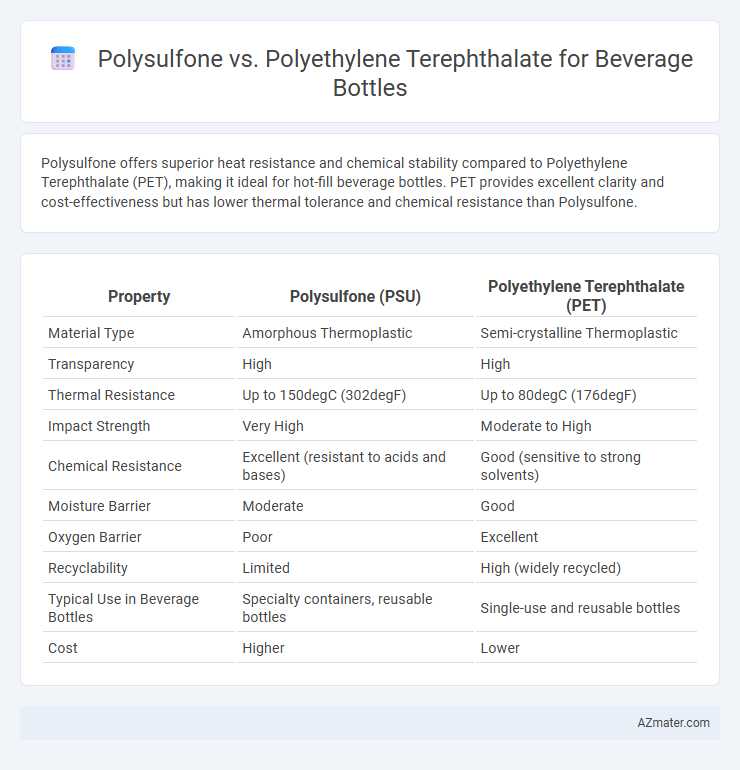Polysulfone offers superior heat resistance and chemical stability compared to Polyethylene Terephthalate (PET), making it ideal for hot-fill beverage bottles. PET provides excellent clarity and cost-effectiveness but has lower thermal tolerance and chemical resistance than Polysulfone.
Table of Comparison
| Property | Polysulfone (PSU) | Polyethylene Terephthalate (PET) |
|---|---|---|
| Material Type | Amorphous Thermoplastic | Semi-crystalline Thermoplastic |
| Transparency | High | High |
| Thermal Resistance | Up to 150degC (302degF) | Up to 80degC (176degF) |
| Impact Strength | Very High | Moderate to High |
| Chemical Resistance | Excellent (resistant to acids and bases) | Good (sensitive to strong solvents) |
| Moisture Barrier | Moderate | Good |
| Oxygen Barrier | Poor | Excellent |
| Recyclability | Limited | High (widely recycled) |
| Typical Use in Beverage Bottles | Specialty containers, reusable bottles | Single-use and reusable bottles |
| Cost | Higher | Lower |
Introduction to Beverage Bottle Materials
Polysulfone and polyethylene terephthalate (PET) are prominent materials in the beverage bottle industry, each offering distinct properties that affect performance and sustainability. Polysulfone is known for its high thermal stability, chemical resistance, and durability, making it suitable for reusable and sterilizable bottles. PET is widely favored for its excellent clarity, lightweight nature, and recyclability, dominating single-use and disposable beverage packaging markets.
Overview of Polysulfone (PSU)
Polysulfone (PSU) is a high-performance thermoplastic known for its exceptional thermal stability, chemical resistance, and mechanical strength, making it suitable for demanding beverage bottle applications. Unlike polyethylene terephthalate (PET), PSU maintains structural integrity at elevated temperatures and resists hydrolysis, which is critical for hot-fill or sterilized beverage processes. The polymer's inherent transparency and ability to withstand repeated sterilization cycles without degradation offer advantages in durability and product safety over conventional PET bottles.
Overview of Polyethylene Terephthalate (PET)
Polyethylene Terephthalate (PET) is a lightweight, durable thermoplastic polymer extensively used in beverage bottles due to its excellent clarity, strength, and resistance to impact and chemicals. Its superior barrier properties protect against moisture and gases, preserving the beverage's freshness and flavor over extended periods. PET's recyclability and cost-effectiveness make it a preferred choice over materials like polysulfone in large-scale beverage packaging applications.
Mechanical Strength Comparison: PSU vs PET
Polysulfone (PSU) exhibits superior mechanical strength compared to Polyethylene Terephthalate (PET), offering higher tensile and impact resistance, making it suitable for demanding applications requiring durability. PET, while providing adequate strength for standard beverage bottles, demonstrates lower resistance to deformation and impact relative to PSU. The rigidity and thermal stability of PSU outperform PET, contributing to enhanced performance under mechanical stress in beverage packaging.
Thermal Stability in Beverage Applications
Polysulfone exhibits superior thermal stability compared to Polyethylene Terephthalate (PET), maintaining structural integrity and performance at temperatures up to 150degC, which is crucial for hot-fill beverage applications. PET, while widely used for cold and room temperature beverages due to its clarity and cost-effectiveness, begins to deform at temperatures above 70degC, limiting its use in thermal processing. The enhanced thermal resistance of polysulfone ensures better durability and safety in beverage packaging subjected to heat, making it ideal for sterilization and hot-fill processes.
Chemical Resistance and Compatibility
Polysulfone (PSU) exhibits superior chemical resistance against a wide range of acidic and alkaline substances compared to Polyethylene Terephthalate (PET), making PSU highly suitable for aggressive beverage formulations. PET offers excellent compatibility with carbonated and acidic beverages but may degrade or leach under prolonged exposure to strong chemicals. The inherent thermal stability and solvent resistance of polysulfone ensure enhanced durability and safety in chemical-intensive environments, whereas PET is favored for lightweight, cost-effective beverage packaging with moderate chemical exposure.
Impact on Beverage Taste and Safety
Polysulfone exhibits excellent thermal stability and chemical resistance, minimizing the risk of leaching harmful substances, thus preserving beverage taste and ensuring safety. Polyethylene terephthalate (PET) is widely used due to its strong barrier properties and inertness, which prevent contamination and maintain the original flavor profile of beverages. Comparative studies show polysulfone's lower permeability to gases may offer superior freshness retention, but PET's proven safety record and recyclability often make it the preferred choice for beverage packaging.
Recyclability and Environmental Considerations
Polysulfone (PSU) is a durable, heat-resistant polymer that is less commonly recycled due to limited recycling infrastructure and its chemical resistance, posing challenges in waste management compared to Polyethylene Terephthalate (PET). PET is widely recycled with an established global recycling system, significantly reducing environmental impact by enabling bottle-to-bottle recycling and decreasing landfill accumulation. The environmental footprint of PET is lower owing to its high recyclability and lower energy requirements in recycling processes, while PSU's long-term environmental impact remains less understood due to fewer recycling options and its persistent nature.
Cost-Efficiency and Manufacturing Scalability
Polysulfone offers high thermal stability and chemical resistance but comes with significantly higher raw material and processing costs compared to Polyethylene Terephthalate (PET), making it less cost-efficient for mass beverage bottle production. PET, widely used in the beverage industry, benefits from well-established manufacturing infrastructure and economies of scale, enabling scalable production with lower energy consumption and faster cycle times. The superior cost-efficiency and scalability of PET manufacturing make it the preferred choice over polysulfone for high-volume beverage packaging applications.
Choosing the Best Material for Beverage Bottles
Polysulfone offers superior thermal stability and chemical resistance, making it ideal for hot-fill or sterilizable beverage bottles, while polyethylene terephthalate (PET) excels in lightweight, cost-effective packaging with excellent clarity and recyclability for cold beverages. PET's high tensile strength and barrier properties against oxygen and moisture enhance shelf life, whereas polysulfone's durability withstands repeated sterilization without degrading. Selecting the best material depends on the specific beverage type, processing requirements, and sustainability goals, with PET favored for mass production and Polysulfone suited for niche applications needing high-performance features.

Infographic: Polysulfone vs Polyethylene Terephthalate for Beverage Bottle
 azmater.com
azmater.com